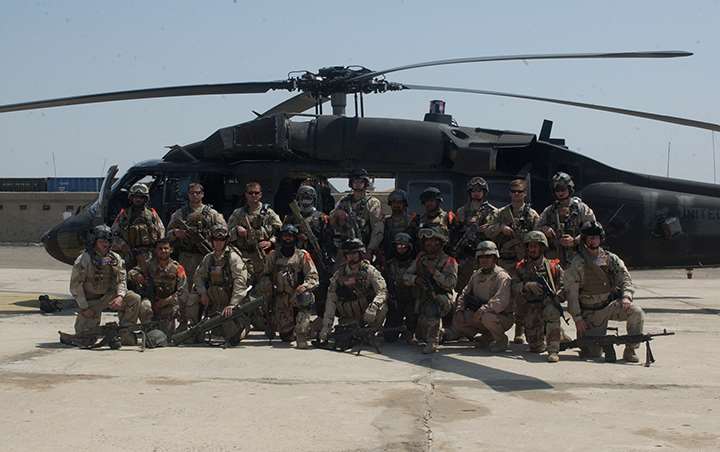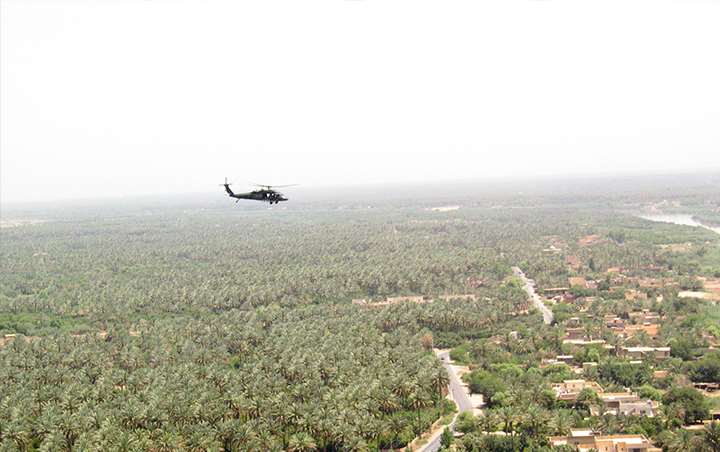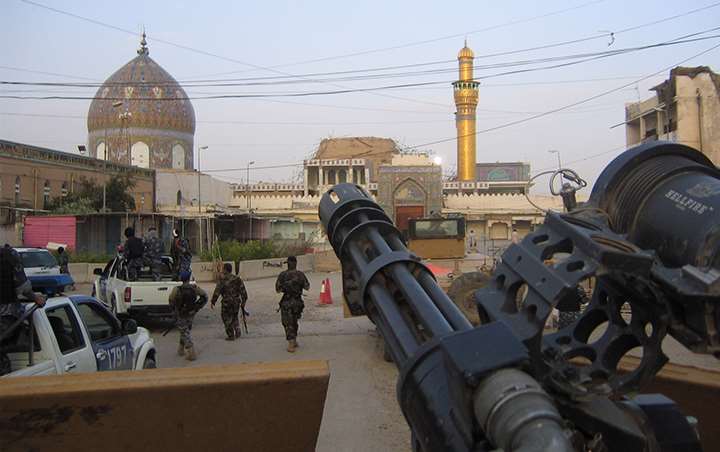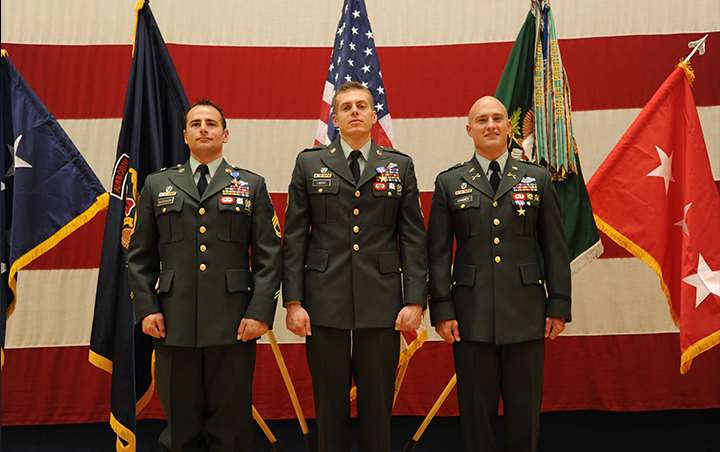
It's difficult to imagine what an 18th century, Danish-born master strategist of the Imperial German Army might have in common with a 21st century, Midwestern-born Green Beret.
One studied Carl von Clausewitz and Napoleon, and during a 69-year career in four armies changed the way virtually every Western nation fought their wars. He was Generalfeldmarschall Helmuth Karl Bernhard Graf von Moltke.
The other joined the U.S. Army at 21. He’s as American as Jeeps and homemade jam. A mechanically minded, genial family man, he is as hard working a Michigander as may be, barring—perhaps—that Ford fella. He is Master Sergeant Jarion HalbisenGibbs, 10th SFG (A).
Both sergeant and feldmarschall served their nations with distinction. But across thousands of miles and more than 110 years, any other nexus seems unlikely—or so it would seem, but for a moonless September 2007 night in Salah ad Din Province, Iraq. Then, the timeless distillation of von Moltke’s martial scholarship became a resonating, life-and-death imperative for HalbisenGibbs: No plan survives contact with the enemy.
The Badlands of Samarra
Samarra was a rough town by the time Operational Detachment-Alpha 083 reached there in March 2007 to gather intelligence and train Iraqi National Police personnel. Situated nearly in the center of the Sunni Triangle, the ancient city’s 350,000 inhabitants perch mostly on the east bank of the Tigris River, 78 miles north of Baghdad on Iraq’s Highway 1.
Evidence of strife in the city was plain: The famed gold dome of the al-Askari Mosque already lay shattered in the wake of a February 2006 bomb attack; the resulting riots claimed hundreds of lives. Two minarets and a clock tower remained, but these were attacked and destroyed in the summer of 2007. Particularly in the last two attacks, al Qaeda insurgents were suspected.
Virulent sectarian and anti-government violence had grown in Samarra as insurgent al Qaeda groups like the Islamic State of Iraq (ISI) fled Baghdad, where the Surge was having the desired effect. Iraqis were stepping up to form their own National Police, and Iraqi-on-Iraqi violence was declining. Al Qaeda was looking for easier pickings in suburban Baghdad and more rural areas of Iraq, and for new havens in which to regroup, train, cache weapons and finance their operations.
In this sense, Abu Obaeideah was one of ISI’s best, and “Minster of Defense” in Salah ad Din province. His specialties of kidnapping for ransom and intimidation—or the outright murder of—candidates for policemen and their family members, were prized by al Qaeda. He operated essentially unfettered, his organization using “day jobs” as cover for their other activities. With little in the way of coalition force activity in the area, many operatives even lived in their own homes. By September 2007, Obaeideah had been on the intelligence “radar” for a year, becoming a high value target.
In response, ODA-083 had been planning “Operation Chromium”—the broad strokes of an operation to capture and detain Obaeideah—for more than a month. They’d been thwarted in classic fashion: Their target never stayed longer than a few days in a single location. On Sept. 6, they caught a break. A friendly tribal contact reported Obaeideah northeast of Samarra in a farming area called Al-Jalam, where he had commandeered a house.
The team put this intel right to work. Air assault execution details were fleshed out based on the hard location. Blocking positions and inner cordon were identified and assigned. Progressive breaching—it was unclear which of three closely spaced buildings Abu Obaeideah would actually be in—was laid out. Med evac and quick reaction force were on standby, the latter a worrisome 50 minutes away.
In the end, the plan called for ODA-083 to assist 17 Iraqi National Police personnel on the early morning raid. At 2 a.m. on Sept. 10, three heavily loaded UH-60s left the team HLZ in Samarra for a 20-minute hop to the target.
Chromium Loses Its Shine
The plan called for the helicopters to land the entire assault force in a field adjacent to the three-building compound, close enough to allow for a rapid deployment and establishment of a perimeter, but not so close as to arouse immediate alarm and provide time for escape. Courtesy of the feldmarschall, there was just one problem—their landing zone was under water.
The idea of setting 20,000-pound Blackhawks down in the planned location was a non-starter with pilots and commanders alike. This alone would have been reason enough to scrub the mission, but also to lose a precious—and perhaps irreproducible—opportunity. Instead, the landings were split. Bird 1, carrying Capt. Matthew Chaney, Sergeant First Class Michael Lindsay, Staff Sgt. Jarion HalbisenGibbs and their INP counterparts would land “on the X,” within 30 yards of the first building. Bird 2 angled for the next closest safe landing zone—roughly 300 meters from the compound. Bird 3 stayed aloft as an aerial quick reaction force.
As they left Bird 1, Chaney, Lindsay, HalbisenGibbs and their INP force were about to engage the enemy, but with only a third of the planned strength, and essentially blind in a rotor-wash sandstorm.
On a night already unusually dark (10 percent illumination), the lack of visibility proved challenging for the police troops who were supposed to lead the assault. Instead, they froze. The Green Berets were equipped with night-vision gear, and Chaney made a decision.
“... I saw no other option but to move quickly towards the enemy and destroy them,” he said. They moved on the smallest and closest building, which proved to be a shed. HalbisenGibbs quickly cleared it, and the Green Berets moved on ...
... And stepped right into contact. As they moved toward the remaining buildings, movement appeared at the third building 25 to 30 meters away. In the nearest doorway, a shape resolved—a man with a rifle, raised to fire. As he tried to reach another doorway further along the building, HalbisenGibbs engaged him with his M4.
More intense gunfire quickly filled the compound. Clearly, there was no uncertainty on the part of the defenders, so Chaney, Lindsay and HalbisenGibbs redoubled their efforts. Rather than regroup and rally the INP—which they feared would give Obaeideah’s men a chance to attack either their own helicopter or the about-to-land second UH-60 with RPGs (or worse, to detonate a suicide bomb)—they bypassed the second building as machine gun fire opened up from the third.
The bulk of Obaeideah’s bodyguards had now joined the fight in earnest. Several stepped into the courtyard with AK-47s, firing as they came. The Green Berets returned fire, killing them all. The second Blackhawk had now landed on the far side of the compound, but brought with it another rotorwash cloud.HalbisenGibbs, on point, fired through the cracked-open door and followed his shots with a fragmentation grenade, waited for the detonation, and pushed into the room.
Chaney, Lindsay and HalbisenGibbs had reached the door of the third building—the most likely to contain Abu Obaeideah. Chaney gave the signal to enter. HalbisenGibbs, on point, fired through the cracked-open door and followed his shots with a fragmentation grenade, waited for the detonation, and pushed into the room. He ran into a hail of gunfire: His night vision, communication equipment and dominant hand were hit. Chaney and Lindsay followed close behind, and both were also hit—Chaney in the pelvis, Lindsay in the throat and abdomen—but both kept firing into the room. In only seconds the Green Berets had neutralized multiple insurgents, but not before one mortally wounded enemy dropped the hand grenade he was preparing to throw—von Moltke again.
The resulting explosion launched Lindsay and Chaney back through the building’s door. HalbisenGibbs, partially entangled in the feet of a dead bodyguard, was thrown into the corner of the room, landing atop a still-resisting foe. Only feet from the grenade’s detonation, it took several seconds for the room to clear sufficiently for HalbisenGibbs to regain his bearings and assess “the now chaotic structure,” all while subduing the fighter beneath him. HalbisenGibbs was then hit by more gunfire, this time in the right foot.
Chaney and Lindsay continued to engage outside, but both were now seriously wounded. Lindsay, too weakened by blood loss from his wounds and the resultant vomiting and hyperventilation to hold his M4, nevertheless drew his sidearm and continued to fire. Chaney, crawling due to his fractured pelvis and broken tailbone, found scant cover and engaged a remaining Obaeideah bodyguard who was firing from a second entrance to the building. Killing him, he continued to cover the doorway. The second assault force had now arrived from their more distant landing zone, and Chaney directed them to clear the second structure, which they had bypassed in their initial assault.
HalbisenGibbs had finished clearing the main room of building three by now, despite his compromised night vision, and emerged to check on his comrades. Chaney was against an outer wall and at least slightly secure in his position. “Mike was out in the middle of the courtyard, and making sounds you never want to hear from your brother,” HalbisenGibbs said.
As he approached Lindsay, however, the shade of von Moltke rose again.
A last enemy materialized in the second doorway of building three, but out of Chaney’s line of fire. He shot HalbisenGibbs with a handgun from about 12 feet away, striking him just below his chest plate.
“I think the guy was actually shooting at Mike but hit me,” he said. “Still, it’s a perfect example of how your training takes over, how muscle memory kicks in and all the range time truly pays off. The bullet felt like an electrical shock going through my guts and then my hip popped out. I did a reflexive fire drill and was able to eliminate the threat to both of us with my M4.”
Finally taking cover to reload, HalbisenGibbs rallied the INP personnel and got them back in the fight. They, and the remainder of the assault team from the second Blackhawk, finished securing the objective.
Generalfeldmarschall von Moltke, apparently, was finished with ODA-083 for the morning.
End Game
Captain Chaney, Sergeant First Class Lindsay and Staff Sergeant HalbisenGibbs received emergency care for their wounds on the Blackhawk as they were evacuated, and later at Balad. Their injuries were serious enough, however, that all three went to Landshtul, Germany, and then home to the United States for completion of their treatment and recovery. All eventually returned to active duty as members of Special Forces.
Operation Chromium remains a major success in the annals of 10th Group and Special Forces, despite the severity of the injuries to members of ODA-083. Abu Obaeideah and 10 bodyguards or cell members were killed (Obaeideah himself was among the nine killed in the main room of building three), and they could no longer kidnap for al Qaeda fundraising, nor harass, intimidate or kill members of the Iraqi National Police or their families in the area.
The terrorist cell had a considerable weapons cache as well—five rocket-propelled grenade launchers (with 20 rounds/grenades), three PKM machine guns, 23 AK47 rifles (90 full magazines), 20 hand grenades and other stolen or salvaged kit. Also captured was $104,000 of local currency—a considerable “operational” resource for a group like this, and evidence of their success in the kidnap-for-ransom game.
Three additional cell members were discovered in the second building, along with a kidnap victim who was subsequently returned to his family. Al Qaeda lost a “safe house”/kidnap detention facility and three vehicles. And while Iraqi National Police were challenged in the operation’s early stages, their presence combined with the release of the hostage helped generate significant support from the local population. The lessons of Operation Chromium not only paid dividends down the road in Salah ad Din province but have also been widely disseminated through the Special Forces community—to the benefit of many, and well beyond Iraq.
It takes no imagination whatsoever to assess the value of the efforts of Chaney, Lindsay and HalbisenGibbs in the eyes of their peers. For their valor, Captain Chaney and Sergeant First Class Lindsay received the Silver Star. Staff Sergeant HalbisenGibbs was awarded the Distinguished Service Cross.
In retrospect, however, HalbisenGibbs (now a Master Sergeant) speaks pointedly.
“It was truly humbling to be honored with that award,” he said. “Warrior culture reveres the sacrifices of our forefathers and the lessons passed on from generation to generation, but we are only able to accomplish what we have by standing on the shoulders of giants.
“Unfortunately there tends to be a ‘more’ or ‘less’ perception when it comes to awards and actions on the objective, but combat doesn’t work like that. None of us would have survived without the others. We were all seriously wounded, but still did what we had to do to win. The Team is what mattered, and the Team is what carried the day.”
Which brings us back, just maybe, to where we started.
Many plans did not survive contact that September night. But the worst by far was for those who did not reckon on the Green Berets of ODA-083.



































